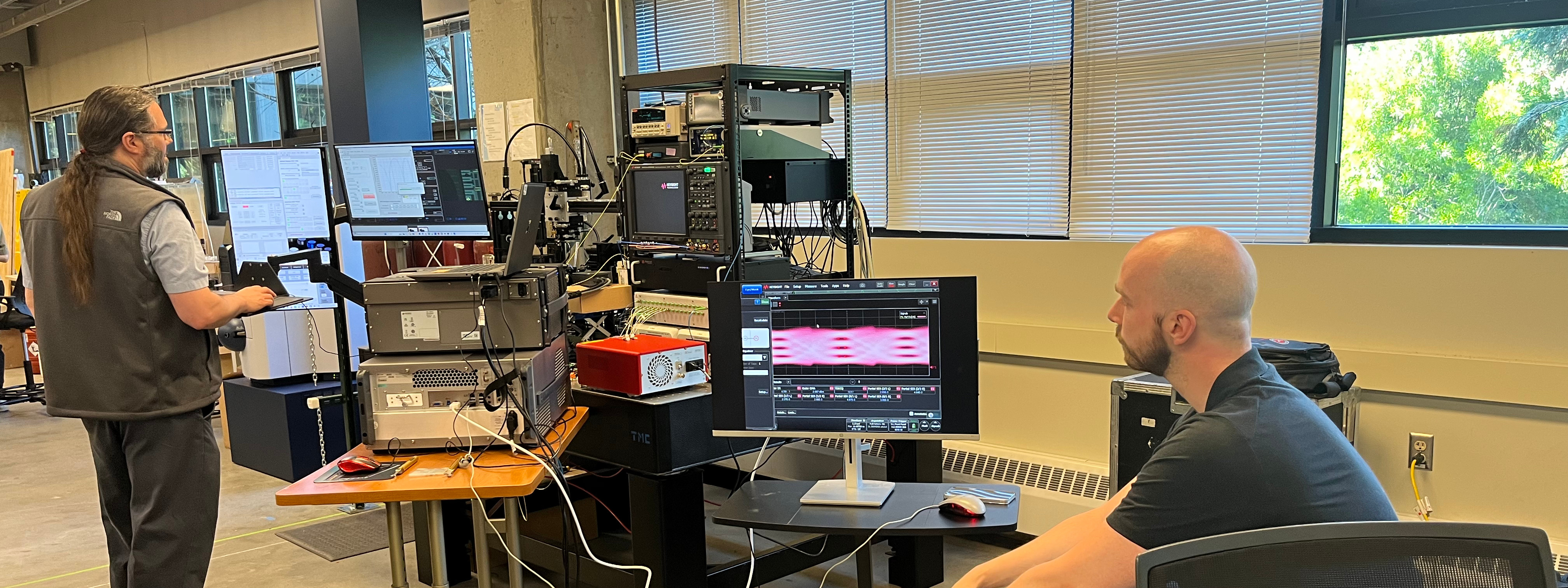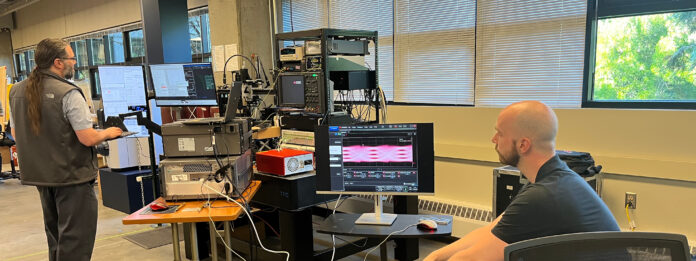Silicon-Organic Hybrid Photonic Integrated Circuits Achieve Record-Breaking 0.31 V-mm Modulation Efficiency and Industry-Leading 110 GHz Bandwidth Performance, Demonstrating Commercial Scalability and a Path to 400G Silicon PICs
SEATTLE, WASHINGTON / ACCESS Newswire / September 30, 2025 / NLM Photonics, a leader in hybrid organic electro-optic (OEO) technology, today announced breakthrough validation results from third-party testing of multi-channel silicon-organic hybrid (SOH) photonic integrated circuits (PICs) capable of 1.6 terabit (1.6T) and 3.2 terabit (3.2T) performance. In addition to record-breaking modulation efficiency and bandwidth, NLM’s 1.6T SOH PIC achieved 224Gbit/s per channel data transmission in tests. These results represent real-world improvements in 200G performance and pave the way for 400G in a commercially available silicon photonics platform.

Dr. Scott Hammond and a Keysight Technologies Employee Test NLM’s SOH PICs
NLM’s testing confirmed multiple industry firsts, including a world record SOH modulation efficiency of 0.31 V-mm on the best single channel, representing a 10- to 15-times improvement over traditional silicon photonic modulators. In bandwidth testing performed by VLC Photonics, the technology delivered industry-leading 3 dB bandwidths exceeding 80 GHz for 200G components and up to 110 GHz for 400G components – performance far beyond traditional silicon photonics.
Testing performed at NLM’s lab in collaboration with Keysight Technologies verified 224 Gbps PAM4 data transmission with exceptionally low driver voltage requirements. This enables significantly more energy-efficient operation while maintaining consistent multi-channel performance across eight channels, with only 10 percent inter-channel variation in Vπ.
The PICs tested were designed in collaboration with Enosemi and fabricated on Advanced Micro Foundry’s (AMF) O-band GP v4.5 200mm silicon photonics platform to specifications developed by Centera Photonics. The total area for the 1.6T SOH PIC is only 17 mm² for the complete 8-channel system: significantly more compact than competing technologies. This testing validates that, using NLM’s SOH technology, commercially available silicon photonics platforms can break the 200G barrier, with a clear path to 400G and beyond.
“The demand from AI data centers for high bandwidth and lower power, while not breaking the bank, is creating unprecedented challenges for the photonics industry,” said Brad Booth, CEO of NLM Photonics. “Traditional photonic platforms are severely challenged to meet next-gen demands. Our 1.6T and 3.2T SOH PICs demonstrate the ability of NLM’s solutions to permit silicon photonic platforms to continue to scale to higher bandwidths while reducing a PIC’s footprint by at least 40 percent.”
“As a co-inventor of the slot waveguide silicon-organic hybrid modulator along with Michael Hochberg, I’ve witnessed this technology’s evolution from laboratory curiosity to commercial reality,” said Tom Baehr-Jones, CEO of photonics software firm Tesselmax, co-founder of Luxtera and Elenion, and Optica fellow. “NLM’s breakthrough results represent something we’ve been working toward for two decades – real-world 200G performance that is scalable for production and a clear path to 400G on commercially available silicon photonics platforms, and with order-of-magnitude performance improvements over what silicon photonics can achieve without organic materials. Modulation is one of the most important aspects of silicon photonics systems, and this is a timely result in light of the pressing need for higher speed and lower power devices.”
Michael Hochberg, co-founder of Luxtera and Elenion and co-inventor of silicon-organic hybrid technology, commented, “This is a very exciting result. Integrating polymers onto these silicon platforms is challenging; it’s been a long road, and it’s nice to see it finally come together.”
A video of the testing process can be found on NLM’s YouTube channel.The full validation testing results are included in NLM’s research paper. These results will be presented at two upcoming October conferences: Optica and the APC Photonic-Enabled Cloud Computing (PECC) Industry Summit and the Keysight Summit: TeraScale AI, 1.6T, and Beyond Seminar.
If you are interested in meeting with NLM Photonics at ECOC, please contact press-relations@nlmphotonics.com.
About NLM Photonics
NLM Photonics develops cutting-edge organic electro-optic modulation technology transforming data centers, AI, communications, and quantum computing. Our patented OEO technology enables higher bandwidth and lower power consumption while requiring minimal process disruption, helping solve critical challenges in efficiency and sustainability. Built on over two decades of research and development, NLM’s technology breakthroughs enable the next generation of high-performance communication. Find us at nlmphotonics.com and on LinkedIn @nlm-photonics.
Contact Information
Theo McGillivray
Communications Director
press-relations@nlmphotonics.com
SOURCE: NLM Photonics
View the original press release on ACCESS Newswire












